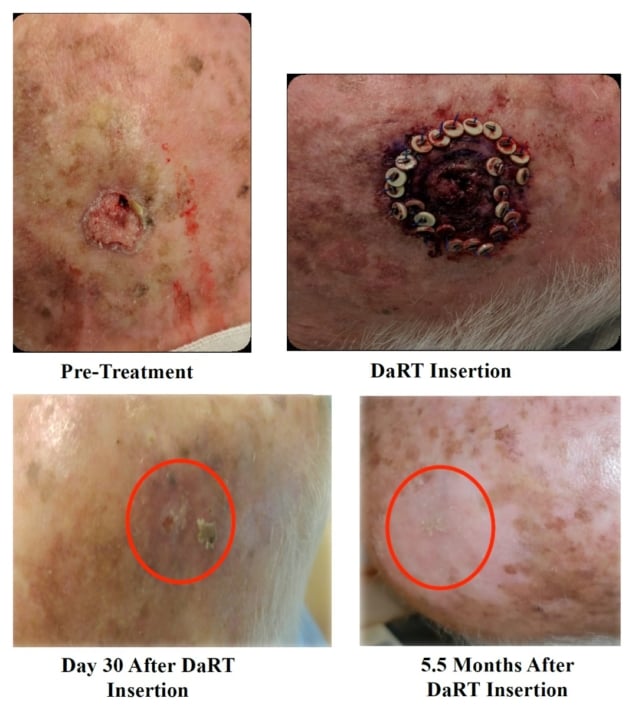
Diffusing alpha-emitters radiation therapy (DaRT) uses interstitial radioactive seeds that continually release short-lived alpha-emitting atoms to treat cancer. Researchers in Israel have now published the positive results of a first-in-human clinical study evaluating the feasibility, safety and efficacy of this novel radiotherapy technique (Int. J. Radiat. Oncol. Biol. Phys. 10.1016/j.ijrobp.2019.10.048).
The clinical trial examined Alpha DaRT treatment, developed by Alpha Tau Medical. The therapy uses seeds (10 mm long and 0.7 mm diameter) impregnated with 224Ra atoms, which are implanted percutaneously into a solid tumour. As the 224Ra decays, short-lived daughter atoms (220Rn, 216Po, 212Bi, 212Po and 208PB), which are mainly alpha emitters, are continually released into the tumour.
Alpha radiation has a high relative biological effectiveness, enabling the use of a lower radiation dose to induce damage. The diffusing emitters create a cluster of high-energy alpha particles that destroy tumour tissue over a radius of 3 mm and do not affect healthy surrounding tissue.
First-in-human trial
The study, led by principal investigator Aron Popovtzer, of Rabin Medical Center and Tel Aviv University, included 22 patients at Rabin Medical Center in Israel and six patients at the Instituto Scientifico Romagnolo per Lo Studio e la Cura dei Tumori in Italy. All patients had biopsy-proven squamous cell carcinoma (SCC) of the skin and head-and-neck, with 39% having primary and 61% recurrent tumours that were no larger than 5 cm.
The researchers note that the patient cohort was elderly (a median age of 81) and represented a highly unfavourable prognostic risk group. Many were not candidates for surgery due to increased risk of morbidity. Three patients were treated twice for two separate tumours. All patients with recurrent disease had either received radiotherapy, surgical excision or both, with 13 of the 31 lesions previously treated using external-beam radiation therapy.
Before the procedure, which was performed in an outpatient setting under local anaesthesia, patients had a CT scan to determine the pre-treatment tumour volume and plan the number of Alpha DaRT seeds required. Alpha DaRT seed strands were placed at 5-mm intervals, extending 5 mm beyond the tumour edge to achieve adequate dosimetric coverage, and at a distance of at least 10 mm from major blood vessels. The team also performed a post-procedure CT to confirm that seed positions conformed to the treatment plan.
Between three and 169 seeds were inserted into each tumour, with an average of 28 seeds. Treatment lasted 16 days on average. Patients attended multiple follow-up visits within 45 days, for tests including radioactivity measurements at the tumour site, at different body sites, and in blood and urine samples. The authors point out that that radiation levels to the lungs, kidneys and bone marrow were well within the maximum tolerated doses, and that no measurable radioactivity was detected in blood and urine samples 30 days after treatment.

Out of 28 evaluable lesions, 78.6% had a tumour reduction of 100% and 21.4% had reductions between 30% and 100%, many within 14 days following treatment completion. Fifteen of 16 patients who did not receive prior radiotherapy had a complete response, and seven of 12 patients who had prior radiotherapy also had a complete response. Five lesions that showed complete response developed a local relapse at the site of DaRT implantation within a median of five months.
The participants sustained only mild-to-moderate toxicities from the Alpha DaRT treatment. Nearly half of the patients experienced an acute toxicity of Grade 2; no patients had Grade 3 or higher toxicities, and all cases resolved within 30 days. In eight patients where seeds were inserted adjacent (less than 5 mm) to bone and teeth, none developed osteoradionecrosis.
“The initial local response, with 60% manifesting complete resolution of disease, seems superior compared to outcomes previously reported using standard re-irradiation,” the authors stated. “Favourable response achieved with Alpha DaRT therapy had similar effectiveness in recurrent as in primary treatment tumours. These findings may in part be attributed to the enhanced radiobiologic attributes associated with alpha particle therapy, which could potentially overcome radioresistant clones.”

Alpha particles treat deeper into solid tumours
Alpha Tau Medical is currently conducting and initiating clinical trials in Canada, France, Israel, Japan and Russia, for breast, head-and-neck and skin cancer, with interim results expected to become available in 2020. A clinical trial for use of Alpha DaRT on pancreatic cancer will also commence this year.
“Collaborations with numerous cancer centres around the world have been initiated for the investigation of Alpha DaRT for the treatment of additional indications,” Alpha Tau Medical’s clinical research manager Na’ama Barel told Physics World. “Protocols in process include those for indications such as vulvar cancer in the UK, skin cancer in Thailand and prostate cancer at multiple locations.”



